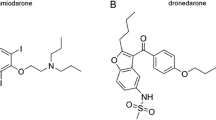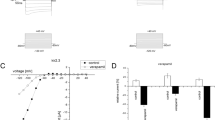Abstract
Previous studies in pigs and goats have demonstrated that AVE0118 prolongs atrial refractoriness without any effect on the QT-interval. The purpose of the present study was to investigate the effect of the compound on various cardiac ion channels. AVE0118 blocked the pig Kv1.5 and the human Kv1.5 expressed in Xenopus oocytes with IC50 values of 5.4±0.7 μM and 6.2±0.4 μM respectively. In Chinese hamster ovary (CHO) cells, AVE0118 decreased the steady-state hKv1.5 current with an IC50 of 1.1±0.2 μM. The hKv4.3/KChIP2.2 current in CHO cells was blocked by AVE0118 by accelerating the apparent time-constant of inactivation (τinact), and the integral current was inhibited with an IC50 of 3.4±0.5 μM. At 10 μM AVE0118 τinact decreased from 9.3±0.6 ms (n=8, control) to 3.0±0.3 ms (n=8). The KACh current was investigated in isolated pig atrial myocytes by application of 10 μM carbachol. At a clamp potential of −100 mV the IKACh was half-maximally blocked by 4.5±1.6 μM AVE0118. In the absence of carbachol, AVE0118 had no effect on the inward current recorded at −100 mV. Effects on the IKr current were investigated on HERG channels expressed in CHO cells. AVE0118 blocked this current half-maximally at approximately 10 μM. Comparable results were obtained in isolated guinea pig ventricular myocytes, where half-maximal inhibition of the IKr tail current occurred at a similar concentration of AVE0118. Other ionic currents, like the IKs, IKATP (recorded in guinea pig ventricular myocytes), and L-type Ca2+ (recorded in pig atrial myocytes) were blocked by 10 μM AVE0118 by 10±3% (n=6), 28±7% (n=4), and 22±13% (n=5) respectively. In summary, AVE0118 preferentially inhibits the atrial K+ channels IKur, Ito and IKACH. This profile may explain the selective prolongation of atrial refractoriness described previously in pigs and goats.










Similar content being viewed by others
References
Amos GJ, Wettwer E, Metzger F, Li Q, Himmel HM, Ravens U (1996) Differences between outward currents of human atrial and subepicardial ventricular myocytes. J Physiol (Lond) 491:31–50
An WF, Bowlby MR, Betty M, Cao J, Ling H-P, Mendoza G, Hinson JW, Mattson KI, Strassle BW, Trimmer JS, Rhodes KJ (2000) Modulation of A-type potassium channels by a family of calcium sensors. Nature 403:553–556
Bachmann A, Gutcher I, Kopp K, Brendel J, Bosch RF, Busch AE, Gogelein H (2001) Characterization of a novel Kv1.5 channel blocker in Xenopus oocytes, CHO cells, human and rat cardiomyocytes. Naunyn-Schmiedebergs Arch Pharmacol 364:472–478
Barry DM, Nerbonne JM (1996) Myocardial potassium channels: electrophysiological and molecular diversity. Annu Rev Physiol 58:363–394
Blaauw Y, Gögelein H, Tieleman RG, van Hunnink A, Schotten U, Allessie M (2004) ‘Early’ class III drugs for the treatment of atrial fibrillation: efficacy and atrial selectivity of AVE0118 in remodeled atria of the goat. Circulation (in press)
Bosch RF, Nattel S (2002) Cellular electrophysiology of atrial fibrillation. Cardiovasc Res 54:259–269
Bosch R, Lazlo R, Schneck AC, Gögelein H, Bleich M, Mewis C, Kuhlkamp V (2002) AVE0118, an antiarrhythmic drug with novel mechanism of action-Block of IKur and Ito potassium currents in human atrial myocytes. Circulation 106:108
Brendel J, Peukert S (2002) Blockers of the Kv1.5 channel for the treatment of atrial arrhythmias. Expert Opin Ther Patents 12:1589–1598
Decher N, Uyguner O, Scherer CR, Karaman B, Yüksel-Apak M, Busch AE, Steinmeyer K, Wollnik B (2001) hKChIP2 is a functional modifier of hKv4.3 potassium channels: cloning and expression of a short hKChIP2 splice variant. Cardiovasc Res 52:255–264
Dilks D, Ling H-P, Cockett M, Sokol P, Numann R (1999) Cloning and expression of the human Kv4.3 potassium channel. J Neurophysiol 81:1974–1977
Dixon JE, Shi W, Wang H-S, McDonald C, Yu H, Wymore RS, Cohen IS, McKinnon D (1996) Role of the Kv4.3 K+ channel in ventricular muscle. A molecular correlate for the transient outward current. Circ Res 79:659–668
Dobrev D, Ravens U (2003) Remodeling of cardiomyocyte ion channels in human atrial fibrillation. Basic Res Cardiol 98:137–148
Dukes ID, Cleemann L, Morad M (1990) Tedisamil blocks the transient and delayed rectifier K+ currents in mammalian cardiac and glial cells. J Pharmacol Exp Ther 254:560–569
Falk RH (1989) Flecainide-induced ventricular tachycardia and fibrillation in patients treated for atrial fibrillation. Ann Intern Med 111:107–111
Fedida D, Wible B, Wang Z, Fermini B, Faust F, Nattel S, Brown AM (1993) Identity of a novel delayed rectifier current from human heart with a cloned K+ channel current. Circ Res 73:210–216
Feld GK (1990) Atrial fibrillation: is there a safe and highly effective pharmacological treatment? Circulation 90:2032–2040
Feng JL, Wible B, Li GR, Wang ZG, Nattel S (1997) Antisense oligodeoxynucleotides directed against Kv1.5 mRNA specifically inhibit ultrarapid delayed rectifier K+ current in cultured adult human atrial myocytes. Circ Res 80:572–579
Gögelein H, Hartung J, Englert HC, Schölkens BA (1998) HMR 1883, a novel cardioselective inhibitor of the ATP-sensitive potassium channel. I. Effects on cardiomyocytes, coronary flow and pancreatic β-cells. J Pharmacol Exp Ther 286:1453–1464
Gögelein H, Brendel J, Busch AE, Bleich M (2004) Effects of AVE0118, a novel inhibitor of atrial K+ channels, on action potentials in isolated atria. Naunyn-Schmiedebergs Arch Pharmacol 369:R67
Hamill OP, Marty M, Neher E, Sakmann B, Sigworth FJ (1981) Improved patch-clamp techniques for high-resolution current recording from cells and cell-free membrane patches. Pflugers Arch 391:85–100
Hart RG, Halpertin JL (2001) Atrial fibrillation and stroke. Concepts and controversies. Stroke 32:803–808
Kannel WB, Abbot RD, Savage DD, McNamara PM (1982) Epidemiologic features of chronic atrial fibrillation. The Framingham Study. N Engl J Med 306:1018–1022
Knobloch K, Brendel J, Peukert S, Rosenstein B, Busch AE, Wirth KJ (2002) Electrophysiological and antiarrhythmic effects of the novel I(Kur) channel blockers, S9947 and S20951, on left vs. right pig atrium in vivo in comparison with the I(Kr) blockers dofetilide, azimilide, d,l-sotalol and ibutilide. Naunyn-Schmiedebergs Arch Pharmacol 366:482–487
Krause E, Englert H, Gögelein H (1995) Adenosine triphosphate-dependent K currents activated by metabolic inhibition in rat ventricular myocytes differ from those elicited by the channel opener rilmakalim. Pflugers Arch 429:625–635
Li GR, Feng J, Yue L, Carrier M, Nattel S (1996) Evidence for two components of delayed rectifier K+ current in human ventricular myocytes. Circ Res 78:689–696
Middlekauf HR, Stevenson WG, Stevenson LW (1991) Prognostic significance of atrial fibrillation in advanced heart failure. A study of 390 patients. Circulation 84:40–48
Nagasawa H, Fujiki A, Fujikura N, Matsuda T, Yamashita T, Inoue H (2002) Effects of a novel class III antiarrhythmic agent, NIP-142, on canine atrial fibrillation and flutter. Circ J 66:185–191
Ohya S, Morohashi Y, Muraki K, Tomita T, Watanabe M, Iwatsubo T, Imaizumi Y (2001) Molecular cloning and expression of the novel splice variants of K+ channel-interacting protein 2. Biochem Biophys Res Commun 282:96–102
Rampe D, Roy ML, Dennis A, Brown AM (1997) A mechanism for the proarrhythmic effects of cisapride (Propulsid): high affinity blockade of the human cardiac potassium channel HERG. FEBS Lett 417:28–32
Seki A, Hagiwara N, Kasanuki H (2002) Effects of NIP-141 on K currents in human atrial myocytes. J Cardiovasc Pharmacol 39:29–38
Singh S, Zoble RG, Yellen L, Brodsky MA, Feld GK, Berk M, Billing CB (2000) Efficacy and safety of oral dofetilide in converting to and maintaining sinus rhythm in patients with chronic atrial fibrillation or atrial flutter—the symptomatic atrial fibrillation investigative research on dofetilide (SAFIRE-D) study. Circulation 102:2385–2390
Tamkun MM, Knoth KM, Walbridge JA, Kroemer H, Roden DM, Glover DM (1991) Molecular cloning and characterization of two voltage-gated K+ channel cDNAs from human ventricle. FASEB J 5:331–337
Torp PC, Moller M, Bloch TP, Kober L, Sandoe E, Egstrup K, Agner E, Carlsen J, Videbaek J, Marchant B, Camm AJ (1999) Dofetilide in patients with congestive heart failure and left ventricular dysfunction. Danish investigations of arrhythmia and mortality on dofetilide study group. N Engl J Med 341:857–865
Villmann C, Bull L, Hollmann M (1997) Kainate binding proteins possess functional ion channel domains. J Neurosci 17:7634–7643
Waldo AL, Camm AJ, deRuyter H, Friedmann PL, MacNeil DJ, Pauls JF, Pitt B, Pratt CM, Schwartz PJ, Veltri EP (1996) Effect of d-sotalol on mortality in patients with left ventricular dysfunction after recent and remote myocardial infarction. The SWORD investigation. Survival with oral d-sotalol. Lancet 348:7–12
Wang Z, Fermini B, Nattel S (1993) Sustained depolarization-induced outward current in human atrial myocytes. Evidence for a novel delayed rectifier K+ current similar to Kv1.5 cloned channel currents. Circ Res 73:1061–1076
Wang Z, Fermini B, Nattel S (1995) Effects of flecainide, quinidine, and 4-aminopyridine on transient outward and ultrarapid delayed rectifier currents in human atrial myocytes. J Pharmacol Exp Ther 272:184–196
Wettwer E, Hála O, Christ T, Heubach JF, Dobrev D, Knaut M, Varró A, Ravens U (2004) Role of IKur in controlling action potential shape and contractility in the human atrium: influence of chronic atrial fibrillation. Circulation (in press)
Wirth KJ, Knobloch K (2001) Differential effects of dofetilide, amiodarone, and class Ic drugs on left and right atrial refractoriness and left atrial vulnerability in pigs. Naunyn-Schmiedebergs Arch Pharmacol 363:166–174
Wirth KJ, Paehler T, Rosenstein B, Knobloch K, Maier T, Frenzel J, Brendel J, Busch AE, Bleich M (2003) Atrial effects of the novel K+-channel-blocker AVE0118 in anesthetized pigs. Cardiovasc Res 60:298–306
Author information
Authors and Affiliations
Corresponding author
Rights and permissions
About this article
Cite this article
Gögelein, H., Brendel, J., Steinmeyer, K. et al. Effects of the atrial antiarrhythmic drug AVE0118 on cardiac ion channels. Naunyn-Schmiedeberg's Arch Pharmacol 370, 183–192 (2004). https://doi.org/10.1007/s00210-004-0957-y
Received:
Accepted:
Published:
Issue Date:
DOI: https://doi.org/10.1007/s00210-004-0957-y




